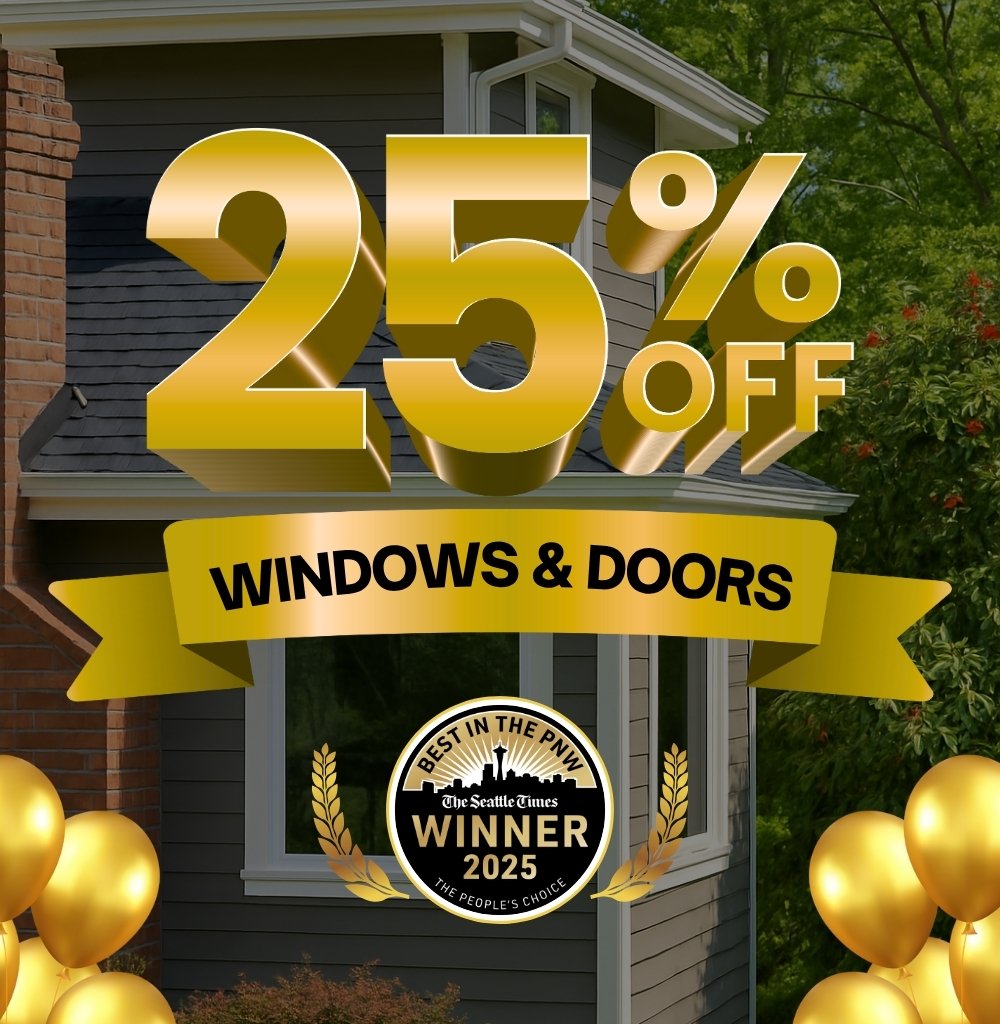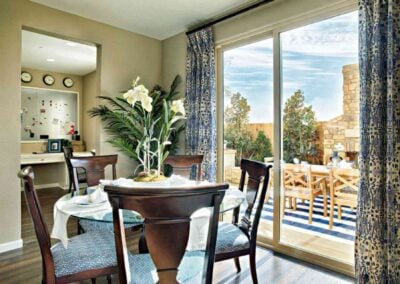The back patio door connects your home to the outdoors, opening up your living space and bringing in natural light, which improves the overall feel and function of your home. Whether you’re working with a compact deck or an expansive backyard, the door you choose plays a key role in both style and day-to-day convenience.
This guide covers the most popular back patio door ideas, focusing on operating styles that fit different homes and lifestyles. From sleek black sliding glass doors to dramatic folding options, we’ll help you narrow down what works best for your space.
Table of Contents
Operating Styles to Suit Your Needs
Back patio doors aren’t one-size-fits-all. The way a door operates can completely change how a space feels and functions, whether you need to save space, maximize a view, or create a wide, open connection to the outdoors. Below are the most popular operating styles to consider, each with its advantages, depending on your layout, design goals, and how you use your patio on a day-to-day basis.
Sliding Back Patio Doors
Sliding patio doors consist of two or more glass panels with at least one panel that glides horizontally along a track to open and close. They operate within the plane of the wall, making them a compact solution that doesn’t interfere with indoor or outdoor space. Benefits include:
- Sliding doors are ideal for patios or decks with limited space because they don’t require any room to swing open.
- The large glass panels help brighten interior spaces by letting in maximum natural light.
- Their horizontal movement makes them easy to open and close, even in high-traffic areas.
- The sleek, minimal frame design enhances expansive outdoor views and gives the door a modern appearance.
- They integrate easily with screen doors, providing continuous airflow while keeping bugs out.
French Patio Doors
French patio doors feature two hinged panels that swing inward or outward from the center. This traditional style is known for its symmetrical design and decorative framing, often making it a focal point in classic or cottage-style homes. French doors are commonly paired with sidelights or transoms to create a more elegant entryway. Benefits include:
- French doors create a wide, welcoming entryway that enhances both indoor and outdoor entertaining spaces.
- The double-door configuration offers a symmetrical, balanced appearance that complements both traditional and transitional architectural styles.
- They can swing inward or outward to suit your space and layout preferences.
- Decorative details, such as grilles, sidelights, and paneling, offer more design flexibility than other styles.
- When fully opened, they provide better ventilation and facilitate easier movement between indoor and outdoor areas.
Bi-Fold Back Patio Doors
Bi-fold patio doors are made of multiple panels that fold and stack to one or both sides when opened, like an accordion. They run along a top and bottom track and can span wide openings, making them ideal for homes that prioritize indoor-outdoor flow. When closed, the panels align tightly to form a wall of glass. Benefits include:
- Bi-fold doors create a wide, uninterrupted opening that seamlessly connects indoor and outdoor living spaces.
- Their folding design allows for maximum flexibility in how much of the doorway you want open at any time.
- The large glass panels provide expansive views and allow plenty of daylight into the home.
- They make a strong visual statement and are often used in high-end or custom home designs.
- When open, the stacked panels occupy minimal space and remain neatly out of the way.
Pocket Back Patio Doors
Pocket patio doors are multi-slide patio doors that open by disappearing into a recessed wall cavity, leaving no visible panels when fully opened. This style requires custom wall construction to accommodate the hidden tracks and pockets but delivers a seamless, minimalist look that blends the interior with the outdoors. Benefits include:
- Pocket doors completely clear the opening, creating an unobstructed path between indoor and outdoor areas.
- The hidden panels maintain clean sightlines and a minimal aesthetic when the door is open.
- They’re ideal for contemporary homes that prioritize simplicity and open space.
- This design maximizes usable space both indoors and out by eliminating visible tracks or stacked panels.
- When closed, they still provide the full benefits of a large glass wall, including natural light and exterior views.
Stacking Back Patio Doors
Stacking patio doors consist of multiple sliding panels that slide in sequence and stack behind one another along a single track. Unlike standard two-panel sliders, this configuration allows for much wider openings and is well-suited for large wall expanses. The panels remain visible when open, but they gather neatly on one or both sides. Benefits include:
- Stacking glass walls allow you to open up a much larger portion of the wall compared to traditional sliding doors.
- The multi-panel design offers flexibility, allowing you to open just one panel or slide them all for full access.
- They provide wide, panoramic views even when closed, thanks to the large glass surface area.
- The sliding operation is smooth and easy, even for wider, heavier panels.
- This style adds a modern, expansive feel that works well for homes with large patios or scenic backyards.
Choose the Best Back Patio Door Materials for Your Home
Choosing the right door style is only part of the decision. The frame materials matter just as much. Rain, wind, and temperature swings make durability and energy performance essential. Here are four of the most reliable patio door materials and how they compare.
Fiberglass Back Patio Doors
Fiberglass patio doors are made from reinforced glass fibers and resins, offering exceptional strength and stability. This material withstands moisture, UV exposure, and temperature fluctuations, making it one of the most weather-resistant options for Pacific Northwest homes.
It won’t warp, swell, or crack, maintaining a tight seal that improves energy efficiency and prevents air or water leaks. Fiberglass frames come in a range of finishes, including options that mimic painted wood, and require very little upkeep over time.
Vinyl Back Patio Doors
Vinyl patio doors are a practical, budget-friendly choice that delivers solid insulation and weather resistance. Made from moisture-resistant PVC, vinyl won’t rot, swell, or deteriorate during rainy seasons.
These doors are low-maintenance, available in fade-resistant colors, and easy to clean. No painting or sealing required. For homeowners focused on value, vinyl offers dependable performance without a high upfront cost.
Aluminum Back Patio Doors
Aluminum patio doors are strong, lightweight, and perfect for designs that call for large glass openings and narrow frames. Their slim profile maximizes natural light and views, making them ideal for modern homes.
Powder-coated finishes resist corrosion and fading, even in wet weather. And with thermal break technology built into many frames, aluminum doors can now offer better insulation than older models.
Clad-Wood Back Patio Doors
Clad-wood patio doors combine the warmth of a real wood interior with the protection of a weather-resistant exterior, usually aluminum or fiberglass. This gives you the elegance of stained or painted wood indoors, with long-lasting durability outside.
The cladding shields the frame from moisture and sun damage, making it a wise choice for areas with high humidity or frequent sun exposure. Clad-wood offers excellent insulation and long-term value without the maintenance required for fully exposed wood.

Schedule a Free Consultation
Get a free home window inspection, talk with one of our design consultants to get product recommendations, and learn about special offers and financing.
10 Things to Consider When Choosing Your Back Patio Doors
The right back patio door looks great while working with your space, climate, and lifestyle. Here are 10 key factors to think through before making your decision:
- Indoor space clearance: Do you have room for doors that swing open, or do you need a sliding or stacking option that stays flush with the wall?
- Outdoor space limitations: If your deck or patio is small, avoid styles that require outward clearance, such as French or bi-fold doors.
- Natural light: Consider how much light you want to bring into the space. Doors with larger glass areas, such as stacking or sliding styles, can brighten up darker rooms.
- Access and traffic flow: Think about how often you will use the door and whether it needs to support foot traffic between kitchen, living, or dining spaces and your backyard.
- Ventilation needs: If airflow is important, look for doors that can accommodate screens and allow partial opening without obstruction.
- Security and locking features: Choose a style that supports multi-point locks or reinforced frames if security is a priority.
- Energy efficiency: Well-insulated doors with proper weatherstripping and energy-efficient glass help maintain indoor comfort, reduce utility costs, and protect against air and moisture infiltration, regardless of your location.
- Durability in wet weather: Make sure your material choice can handle rain, humidity, and temperature swings without warping, rusting, or breaking down.
- Design style: Match the door’s look to your home’s architecture. French doors may suit a craftsman or traditional home while stacking or pocket doors fit a modern build.
- Budget and long-term value: Consider both the upfront cost and the maintenance requirements. A more expensive door that lasts longer with less upkeep might save money in the long run.
Why Professional Back Patio Door Installation Matters
Even the best patio door can fall short if it isn’t installed correctly. A precise, well-executed installation is what ensures lasting performance, keeping out drafts, preventing leaks, and helping your home stay comfortable and efficient year-round. In a wet, wind-prone climate like Seattle’s, that level of detail matters.
Professional installers follow a structured process that begins with accurate measurements and ends with a tight, weather-sealed fit. Along the way, they account for everything from hidden framing issues to local building codes — details that can make or break a project’s success. Unlike DIY approaches or basic installations, experienced crews use techniques and materials that are built to last.
Some of the best contractors also offer enhanced installation systems designed specifically for harsh weather conditions. These may include layered flashing, sill protection, and high-performance sealants that exceed standard industry methods. When done right, these upgrades help reduce moisture intrusion, improve sound insulation, and extend the life of your new patio door.
Whether you’re upgrading for energy efficiency, style, or long-term value, a professional installation gives you the peace of mind that your investment is protected from the inside out.
Ready to Upgrade Your Back Patio Door?
If you’re considering replacing your back patio door, the right operating style and material can significantly impact how your space looks, feels, and functions. Whether you’re trying to open up a view, improve energy efficiency, or make better use of your patio, there’s a solution that fits your home and your needs.
The best way to get started is with a conversation. A professional consultation can help you compare styles, explore material options, and understand what installation would look like in your space. From initial planning to final fit, an expert-led process ensures your new door works beautifully and lasts.














